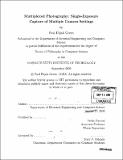Multiplexed photography : single-exposure capture of multiple camera settings
Author(s)
Green, Paul Elijah
DownloadFull printable version (17.22Mb)
Other Contributors
Massachusetts Institute of Technology. Dept. of Electrical Engineering and Computer Science.
Advisor
Frédo Durand.
Terms of use
Metadata
Show full item recordAbstract
The space of camera settings is large and individual settings can vary dramatically from scene to scene. This thesis explores methods for capturing and manipulating multiple camera settings in a single exposure. Multiplexing multiple camera settings in a single exposure can allow post-exposure control and improve the quality of photographs taken in challenging lighting environments (e.g. low light or high motion). We first describe the design and implementation of a prototype optical system and associated algorithms to capture four images of a scene in a single exposure, each taken with a different aperture setting. Our system can be used with commercially available DSLR cameras and photographic lenses without modification to either. We demonstrate several applications of our multi-aperture camera, such as post-exposure depth of field control, synthetic refocusing, and depth-guided deconvolution. Next we describe multiplexed flash illumination to recover both flash and ambient light information as well as extract depth information in a single exposure. Traditional photographic flashes illuminate the scene with a spatially-constant light beam. By adding a mask and optics to a flash, we can project a spatially varying illumination onto the scene which allows us to spatially multiplex the flash and ambient illuminations onto the imager. We apply flash multiplexing to enable single exposure flash/no-flash image fusion, in particular, performing flash/no-flash relighting on dynamic scenes with moving objects. Finally, we propose spatio-temporal multiplexing, a novel image sensor feature that enables simultaneous capture of flash and ambient illumination. (cont.) We describe two possible applications of spatio-temporal multiplexing: single-image flash/no-flash relighting and white balancing scenes containing two distinct illuminants (e.g. flash and fluorescent lighting).
Description
Thesis (Ph. D.)--Massachusetts Institute of Technology, Dept. of Electrical Engineering and Computer Science, 2009. Cataloged from PDF version of thesis. Includes bibliographical references (p. 115-124).
Date issued
2009Department
Massachusetts Institute of Technology. Department of Electrical Engineering and Computer SciencePublisher
Massachusetts Institute of Technology
Keywords
Electrical Engineering and Computer Science.